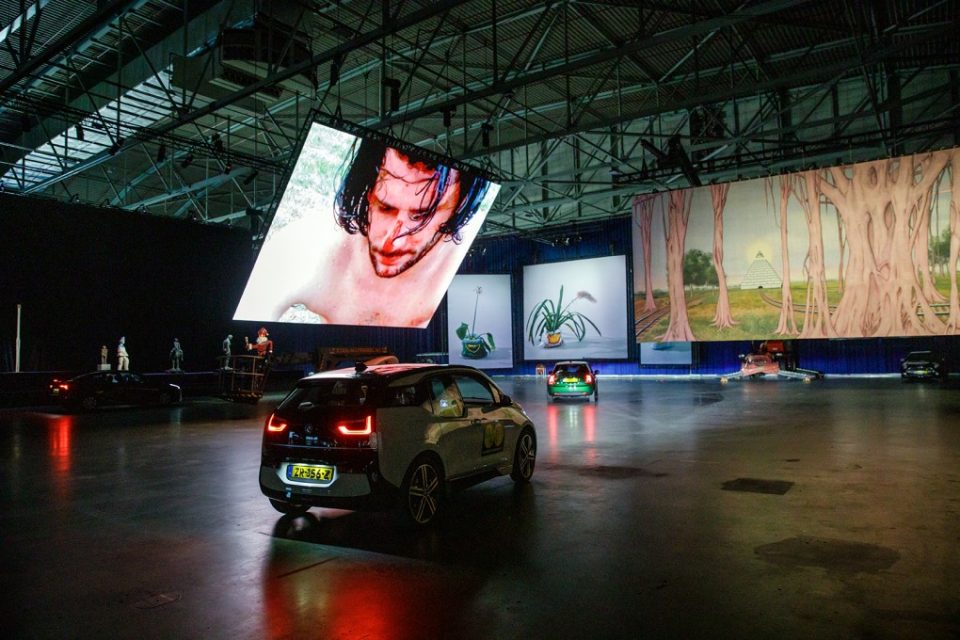
Exhibition view, Booijmans Ahoy Drive-thru Museum
Credit: Aad Hoogendoorn
Exhibition view, Booijmans Ahoy Drive-thru Museum
Credit: Aad Hoogendoorn
Museums and art galleries are fundamentally social spaces. They encourage connection and communication, they are community-based and cultivate relationships with diverse audiences: they are intersections and havens where different social spheres find common ground. Since their emergence in the nineteenth century, their function has grown far beyond displaying riches and educating the public. In fact, the International Council of Museums (ICOM) recently asked its members to review the definition of a museum to reflect this development. It currently reads as follows: “A museum is a non-profit, permanent institution in the service of society and its development, open to the public, which acquires, conserves, researches, communicates and exhibits the tangible and intangible heritage of humanity and its environment for the purposes of education, study and enjoyment.”[1] ICOM’s own motto, ‘Museums have no borders, they have a network’, is perhaps even more telling. How then, can museums continue to fulfil their multiplicity of (social) functions in the present and near future? What is a museum in the age of social distancing? That is the question the art world has been grappling with since the start of the Covid-19 pandemic.
The Dutch Museum Booijmans van Beuningen has come up with a striking answer. Based in Rotterdam, it has been closed for more than a year pending the construction of a new depot, which will be fully transparent and open to the public once it is completed in 2021. In the meantime, Museum Booijmans has been organising exhibitions in collaboration with venues and institutions across Rotterdam, in an effort to keep their beloved collections accessible (and to limit the loss of revenue). The prestigious new facility and the extensive media campaign which accompanies its construction, are a testament to Museum Booijmans’ visionary approach to collections management and its relationship with the public. Despite the delay of its completion due to corona-related restrictions and a government-imposed lockdown this spring, the management of Museum Booijmans has been far from idle. It wasn’t too surprising, therefore, when their initiative of a ‘Drive-thru Museum’ in partnership with Ahoy Rotterdam, a large complex of eventing halls, was announced for the month of August.
The idea is simple: visitors explore artworks displayed in a large, darkened hall in Ahoy from the comfort and safety of an electric car. The exhibition itself consists of a broad mix of Modern and contemporary art (installations, video art, paintings, and sculpture), by Dutch as well as international artists, from the collection of Museum Booijmans. Renting a car for the duration of your visit is free, as electric Minis have generously been provided by BMW, one of the main sponsors of the exhibition. The ‘drive-thru’ concept offers several advantages including proper social distancing without the need for one-way itineraries or limited visitor numbers, but also proposes a completely new way of experiencing and interacting with art. For example, you see the works by the light of the car’s headlights. As you can choose to park by an artwork and/or to drive around it, the play of light and shadows brings an installation to life in a way it never could in a ‘regular’ museum. Another intriguing aspect is the fact that additional information and video sounds are played through the car’s radio. This makes enormous works feel intimate and complex or inaccessible ones feel relevant to you personally.
Most importantly, the ‘drive-thru museum’ heightens the sense of wonder and discovery which you may experience when visiting a museum under normal circumstances. Booijmans’ Drive-thru Museum is like an indoor theme park ride, with the difference that you are free to pick your route. You get in through a tunnel and let the full disorientating effect wash over you: overwhelming at first, but then you start to circulate and explore the space, inch by inch. Like in a theme park ride, you forget the outside world. Whether you are a frequent or first time museum-goer becomes irrelevant – the museum experience is magnified, becomes new. Your visit almost turns into a participation in a performance, because you drive and negotiate the space and the artworks with the drivers around you. Driving, as opposed to wandering a gallery, forces you to play an active part. This is emphasized by the fact that visitors can choose to buy tickets at a reduced price, only giving them access to the ‘Promenade’, a pedestrian area with a rather distant view of the artworks, but a wonderful view of the ballet of BMW Mini’s and their glittering head- and taillights.
The Drive-thru Museum achieves the idea of ‘embodiment,’ a much-debated concept which concerns the connection between art, consciousness, and the body. The emergence of this concept in a museum context is one of the manifestations of the changing function of museums mentioned at the start of this article. Embodiment, or, more concretely, kinetic and visceral experience, may partly make up for the social experience we have lost to the pandemic. The Drive-thru Museum does not lose sight of the social function of museum spaces, however – if anything, you are less likely to visit by yourself than you would a regular exhibition – but adds another dimension to that function. Embodiment is what we gained. It’s a cliché of course, but forced change presents an opportunity for innovation; that is the one silver lining, as the art world hastily reinvents itself to survive. Booijmans’ Drive-thru Museum is a remarkable taste of what is to come.
For more information, you can visit the museum website here: https://www.boijmans.nl/en/exhibitions/boijmans-ahoy-drive-thru-museum
[1] ‘Museum definition’, icom.museum [visited 22/08/20]. https://icom.museum/en/resources/standards-guidelines/museum-definition/